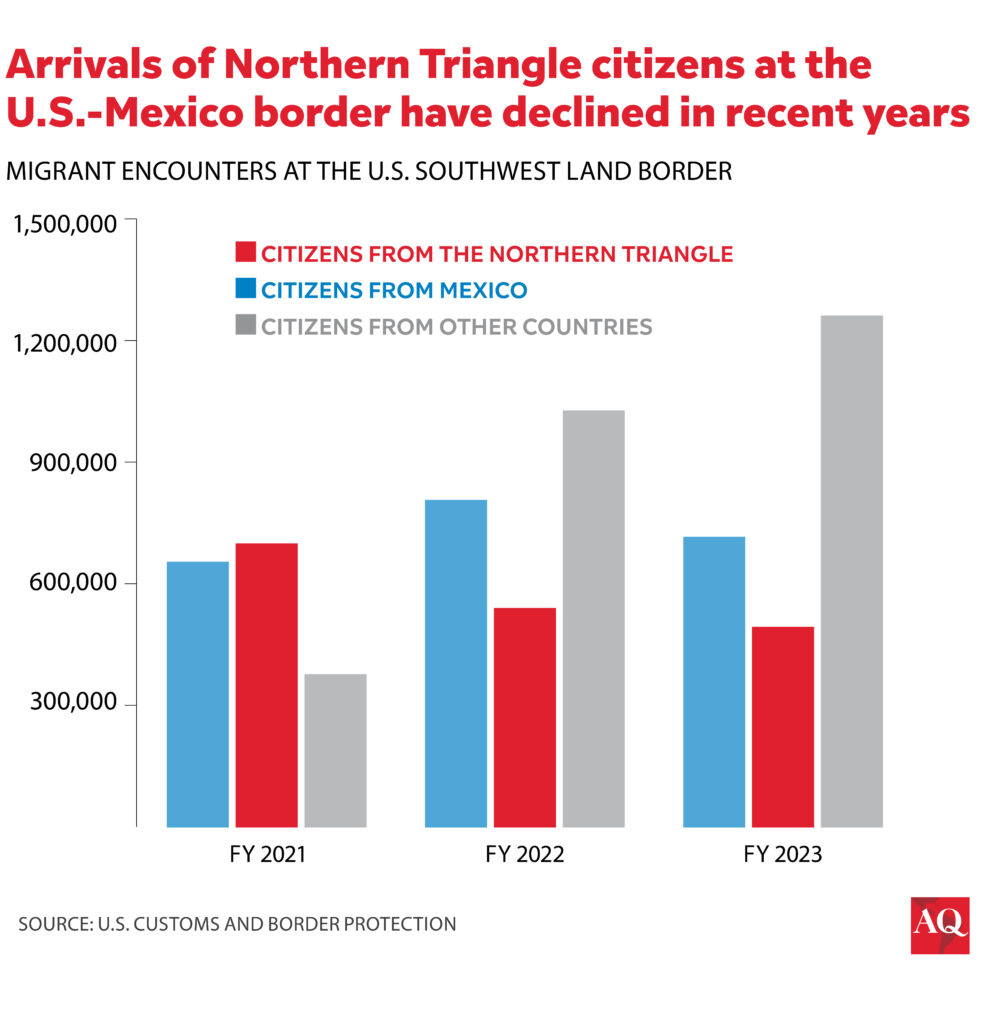MEXICO CITY — In March, tragedy struck when two Honduran migrants were hit by a train in the southern state of Chiapas, killing one of them and seriously injuring the other. This somber event along the Maya Train route served as a poignant reminder of migrants’ perilous journeys through Mexico, the gateway between Central America and the U.S.
Migration across the U.S.’s southern border has become a topic of continuous strain between Washington and Mexico City, and is a major issue in the U.S. presidential election. Mexicans will also head to the polls in June, and although migration is not a primary concern for voters, leading candidates have been forced to address the matter due to increased flows of migrants either settling in Mexico or passing through the country en route to its wealthier northern neighbor. People entering from Central America’s Northern Triangle (Guatemala, Honduras and El Salvador) are an immediate focus of concern, as are the surging numbers of migrants coming from farther-flung areas in the Americas.
Mexico’s next president must depart from past policies and pursue more comprehensive strategies to promote development in its southern neighbors, while improving the management of migration from the Northern Triangle. As a former official dedicated to these matters, during six years as senior advisor on international cooperation to Mexico’s Interior Ministry, I would emphasize that migration is a phenomenon to manage, not solve, and that regional cooperation is essential.
Across the Northern Triangle, complex challenges have cast a long shadow over prospects for development and prosperity. From socioeconomic inequality to political instability, corruption, and the impacts of climate change, the region grapples with issues that resist easy solutions. Mexico finds itself at the heart of these dynamics, and how its new government tackles this protracted issue will most likely set the agenda with the U.S., its biggest trading partner, and recast the relationship with its southern and strategic neighbors.
Migration flows
Citizens of Northern Triangle countries made up 62% of all U.S. southwest border apprehensions in 2019, and after a sharp decrease due to pandemic-related travel restrictions, those detentions rebounded in 2021. But the proportion has since dropped to 20% of all apprehensions at the U.S. southwest border by the end of fiscal year 2023, as border encounters increasingly involve people from countries other than Mexico, Guatemala, Honduras and El Salvador. Still, the proportion remains significant, given the relatively small size of these three countries, with a combined population of 35.5 million.

Migrants from the Northern Triangle also make up a large proportion of asylum seekers in Mexico. According to the Mexican Commission for Refugee Aid (COMAR), out of the 140,948 people who sought refuge in Mexico in 2023, Honduras had the second-highest number of cases (41,936), while El Salvador and Guatemala ranked fourth and fifth, respectively.
Previous approaches
From 2012 to 2018, the administration of Enrique Peña Nieto, through the Mexican Agency for International Development Cooperation (AMEXCID), sought to enhance development in the Northern Triangle by allocating approximately $120.4 million in areas such as road construction and expansion, technical assistance for disaster risk management, national security, water quality monitoring, industrial innovation, and energy efficiency. However, migration from these three countries to Mexico increased by 148% in 2019 compared to 2011. During the same period, the migrant population from Guatemala rose by 59%; from El Salvador, by 136%; and from Honduras, by a staggering 304%.
President Andrés Manuel López Obrador, AMLO, criticized Peña Nieto’s approach and shifted focus to directly implementing development projects in these countries. In 2019, when former President Donald Trump threatened to impose a 25% tariff on all Mexican imports unless measures were taken to curb migrant flows heading north, AMLO announced plans to internationalize some of his flagship social programs, such as Sembrando Vida.
This social assistance program aimed to reduce migration from and reducing poverty in the Northern Triangle by providing support to small-scale agricultural producers. However, the project has yet to yield significant results. According to a multidisciplinary 2023 report, Sembrando Vida’s ambitious goals are still far from being achieved. The report noted that opacity in the program’s implementation undermines efficient monitoring of how Mexican taxpayer money was spent in Central America and found that the funds are not sufficient to assist the number of people expected to benefit. More relevant is the fact that official figures show that migration from target countries, like Honduras and El Salvador, hasn’t decreased.
The Mexican government has allocated $150 million to Central America through this and other social programs, such as Jóvenes construyendo el futuro, a scholarship that funds youth internships, which has also yielded sluggish results in countries like Honduras. However, in January Mexico’s Secretary of Foreign Affairs Alicia Bárcena said that AMEXCID achieved a “paradigm shift,” highlighting cooperation at the state level. “For the first time, social projects are being implemented directly with the target population,” she added.
While intentions count, they require proper execution. In October 2023, AMLO convened the Palenque Migration Summit with heads of state from Latin American and Caribbean nations. It concluded with praiseworthy aspirations of ushering in a new era of cooperation and progress to address migration’s root causes. A post-summit joint communiqué outlined the creation of an action plan for regional development, intraregional trade promotion, and comprehensive migration policies that respect human rights. However, most of this agenda is on hold due, among other reasons, to the electoral context: There are presidential elections this year not only in Mexico but also in Panama, the Dominican Republic, Venezuela and Uruguay.
What Mexico can do
Mexico’s projects in the region have changed with each new president, undermining institutional memory. It is essential for the next Mexican administration to implement policies addressing migration’s root causes, with development efforts that are both auditable and measurable.
One pressing point can be a cornerstone: Mexican and U.S. programs in the Northern Triangle should be aligned. Washington should not be excluded from regional initiatives to foster development and curb migration, as it was at the Palenque Summit. In tandem, Mexico should advocate for international organizations and UN agencies, such as the International Organization for Migration and the UNDP, to increase their presence in the Northern Triangle. Doing so would better target development aid. For example, Mexico’s current migration framework offers some flexibility on labor mobility, but its implementation and reach have so far been limited to small groups of migrants.
The next administration in Mexico will inherit an incomplete and deficient action plan to deal with migration, and the creation of a new strategy must be a priority. Closer cooperation with the Northern Triangle and policy alignment with the U.S. would be a good place to start.








